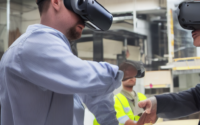The evolution of digital twins in industry
The evolution of digital twins in industry
Introduction to Digital Twins:
Digital twin technology is rapidly evolving in industries like manufacturing, healthcare, automotive, and more. A digital twin is a virtual representation of a physical object or a system that uses real-time data to simulate, analyze, and predict its behavior. This technology has the potential to transform industries by enabling companies to optimize processes, improve decision-making, and reduce operational costs.
Early Development of Digital Twins:
The concept of digital twins originated in the early 2000s and was first introduced by Dr. Michael Grieves at the University of Michigan. Initially, digital twins were used mainly in manufacturing to create virtual replicas of physical assets for monitoring and maintenance purposes.
Advancements in Digital Twin Technology:
Over the years, digital twin technology has advanced significantly, thanks to the integration of IoT sensors, AI algorithms, and cloud computing. These advancements have enabled companies to create more sophisticated digital twins that can mimic the behavior of physical objects in real-time, allowing for predictive analytics and optimization.
Applications of Digital Twins in Industry:
Digital twins have a wide range of applications across various industries. In manufacturing, digital twins can be used to monitor equipment health, optimize production processes, and simulate different scenarios to improve efficiency. In healthcare, digital twins can help in personalized medicine, patient monitoring, and surgical simulations. The automotive industry uses digital twins for designing and testing vehicles virtually before physical prototypes are built.
Challenges and Opportunities:
While digital twin technology offers numerous benefits, there are also challenges that companies face in implementing and maintaining digital twins. Security and data privacy concerns, interoperability issues, and the high cost of implementation are some of the challenges that need to be addressed. However, the opportunities presented by digital twins in terms of predictive maintenance, performance optimization, and enhanced decision-making far outweigh the challenges.
Future Trends in Digital Twin Technology:
Looking ahead, the future of digital twin technology looks promising. As more companies adopt IoT devices, AI technologies, and cloud platforms, the capabilities of digital twins will continue to expand. Integrated digital twins that connect physical assets, product lifecycle data, and AI algorithms will become more common, enabling companies to achieve new levels of efficiency and innovation.

